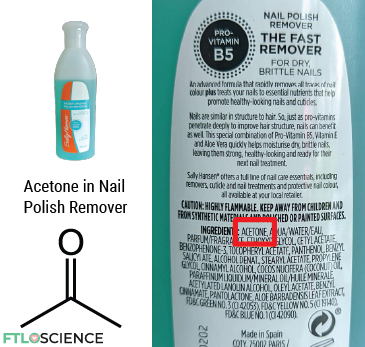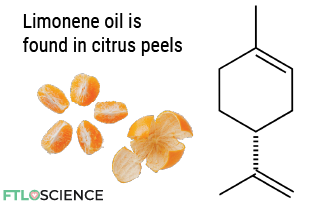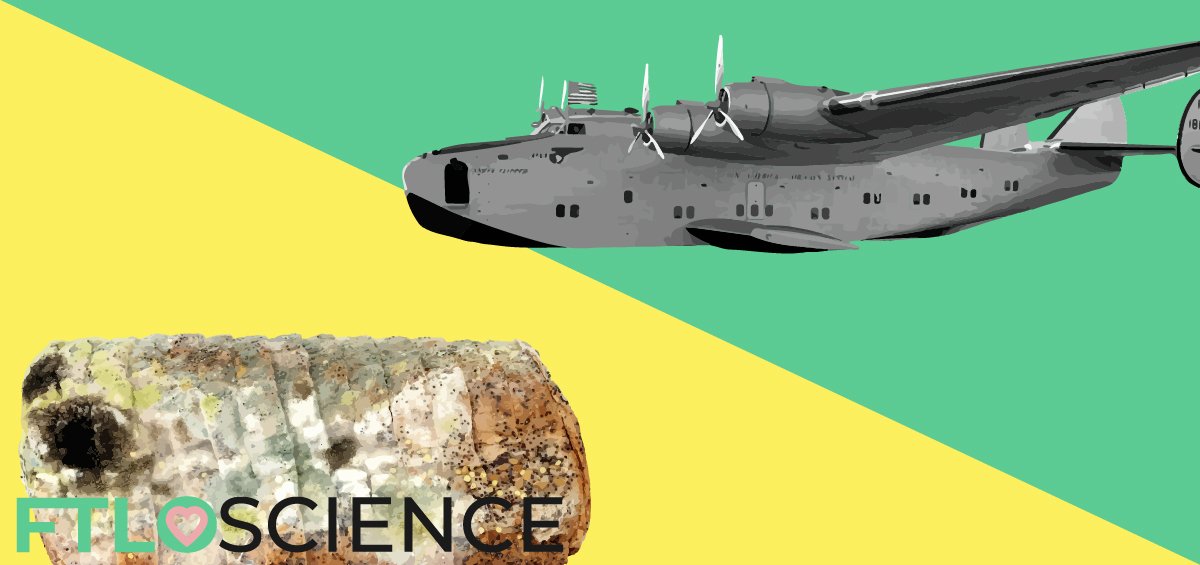Chemists know the best chemicals for keeping their lab clean, but many of these reagents are also useful for removing dirt and stains at home. We look at 11 of the best lab chemicals that can also be used for home cleaning, as recommended by domesticated scientists!
Organic solvents, acids and bases are commonly found in the lab, but these cleaning chemicals can be found at home too! Below is table of reagents the household items they can be found in, along with how each can help with specific cleaning tasks. You can click on the chemical name to jump to the relevant section.
| Chemical | Household Item | Cleaning Purpose |
|---|---|---|
| Acetone | Nail polish remover | Ink remover (stronger than alcohol), dissolves some plastics |
| Ethanol | Alcoholic drinks | Disinfectant, general cleaning |
| Isopropyl alcohol | Rubbing alcohol | Disinfectant, removes ink from surfaces |
| Limonene | Citrus fruits | Removing glue and tar |
| Acetic acid | Vinegar | Removing oils, cleaning windows |
| Citric acid | Baking ingredient | Washing blood stains |
| Phosphoric acid | Coca-Cola | Anti-rust treatment, limescale removal |
| Hydrogen peroxide | Contact lens cleaning solution, acne cream | Disinfectant, bleach |
| Sodium bicarbonate | Baking soda | Deodorizer, fire suppressant |
| Sodium hydroxide | Soap-making kits | Grease remover, drain/pipe cleaner |
| Sodium hypochlorite | Bleach | Cleaning, disinfectant, bleaching of fabrics |
Organic Solvents
Acetone
One of the most effective chemical for general cleaning is acetone, an organic solvent. In labs, you’ll often find them in squeeze bottles to clean glassware with. At home you can find it in nail polish removers.

Acetone is a non-polar solvent, which means it can dissolve things that are non-polar (hates water), such as permanent marker ink. If you’re interested, can read about more about solubility and solvent systems.
Although acetone can remove inks and stains from most surfaces, it shouldn’t be used on plastics. Certain plastics are also non-polar, which means acetone dissolves them too. Below is a video I recorded of Styrofoam cups dissolving in acetone.
Ethanol
Almost every home will have ethanol in the form of alcoholic beverages. Besides causing inebriation, ethanol is also helpful for cleaning and disinfecting surfaces.
It’s slightly less harsh than acetone (it won’t dissolve plastics), so it’s probably a good idea to try using ethanol first to remove ink and stains. In the lab, replacing acetone with ethanol as a cleaning solvent is in line with green chemistry principles.
Isopropyl Alcohol
Although used mainly as a disinfectant (rubbing alcohol), isopropyl alcohol can also be used as a chemical for cleaning.
Its solvent strength is between ethanol and acetone, strong enough to remove most ink stains while keeping any plastic surfaces intact.
It’s a common misconception that ‘baby wipes’ contain ethanol and isopropyl alcohol, but the main ingredient in these is water (aqua), along with small amounts of non-toxic compounds.

Limonene
Limonene comes from the terpene family of molecules that are produced by plants. It is found in the skin (rind) of citrus fruits, giving it a distinct orange flavor.

It’s found in dishwashing liquids and general cleaners, where limonene is used both as a scent and a cleaning chemical. Being non-polar, it is a high-strength stain remover that removes sticky substances like grease and tar.
Although some terpene solvents like turpentine are safety hazards, limonene is safe for human consumption and is used in supplements and perfumes.
Limonene also has a higher flash point (50 °C/122 °F) than turpentine (35 °C/95 °F), which means it is not as flammable.
Acids for Cleaning
Acetic Acid
Some molecules require acidic conditions (below a certain pH) to dissolve, so introducing a weak acid like acidic acid can help remove stubborn grime.
Found in vinegar, acetic acid is a helpful chemical for cleaning fingerprints from surfaces. This is because it dissolves certain water-resistant oils, drying without leaving streaks or stains behind.
If you use vinegar for cleaning, be sure to use white/distilled vinegar rather than black or balsamic vinegar (for obvious reasons).
Citric Acid
Citric acid is available as a baking ingredient. The powder dissolves in water, creating a solution that is a stronger acid (lower pKa value) than acetic acid. It also has the advantage of not having a sour, vinegar scent.

Phosphoric Acid
Phosphoric acid can remove limescale buildup that clogs water pipes. It can also be used to remove rust. Some recommend soaking dirty objects in Coca-Cola, as it contains phosphoric acid.
Phosphoric acid has a pKa of 2.1, making it stronger than acetic and citric acid. Although not as strong as hydrochloric and sulfuric acid, concentrated phosphoric acid solutions can cause skin damage upon contact.
Hydrogen Peroxide
Although hydrogen peroxide is a very weak acid, it is an effective chemical for cleaning when mixed with another acid or base (more details in the Cleaning Recipes section below).
Many people swear by hydrogen peroxide as a blood stain remover. Be careful when using it to clean dyed objects (clothes/carpets), as it can also work as a bleaching agent.
Mixtures of up to 10% hydrogen peroxide in water can be found in grocery or cosmetic stores, as it is a common disinfectant and acne treatment. Higher concentrations are controlled, hazardous substances that can cause severe burns.
Bases for Cleaning
Sodium Bicarbonate
Also known as baking soda, sodium bicarbonate powder can be made into a scrub by mixing it with water. This activates the base and creates an alkaline (pH > 7) environment, which, combined with the friction from the scrub, helps dissolve stubborn stains.
It also absorbs acidic odors (think sour milk) and neutralizes them, so you can leave some baking soda in an open container inside refrigerators and cabinets that smell funky.
Sodium bicarbonate is also useful as a fire extinguishing agent as it releases carbon dioxide, a flame suppressant. It can be thrown directly onto fires in a pinch, just not into containers of hot oil (the gas it forms can cause splattering).
Sodium Hydroxide
An alternative to sodium bicarbonate is sodium hydroxide (NaOH), a stronger base. As a cleaning chemical, it removes grease stains, fats and oils by converting them into fatty acid ions (soap).

This process is known as saponification, creating soap that dissolves in water and can be washed away. Potassium hydroxide (KOH) can be used similarly to sodium hydroxide.
Sodium hydroxide is an ingredient in some drain and pipe cleaners. You can also buy the reagent in both tablet and liquid forms, often as part of soap-making kits. Be careful when using sodium hydroxide at high concentrations, as it is corrosive.
Sodium Hypochlorite
The main ingredient of bleach, sodium hypochlorite, is arguably the most widely used household cleaning chemical. It is used as a cleaning agent, disinfectant, deodorizer, wastewater treatment and for other purposes that harness its corrosive properties.
Since it is a strong base, it is highly corrosive, so handle bleach and other products that contain sodium hypochlorite with caution. Most bleach products contain under 10% sodium hypochlorite by volume, with higher concentrations of up to 25% found in heavy-duty cleaners.
You should never mix bleach with other compounds because the reaction can release chlorine gas, which can be deadly if inhaled. Mixing it with hydrogen peroxide can produce oxygen gas in a violent reaction.
Cleaning Recipes
Some enterprising home chemists have devised concoctions of reagent mixtures to help with household chores. Note that these reactions have not been peer-reviewed.
Isopropyl Alcohol + Acetic Acid/Acetone
Vinegar or acetone mixed with isopropyl alcohol is a mixture that is apparently useful for removing stains from windows.
Acetic Acid + Sodium Bicarbonate
The classic vinegar plus baking soda combination can be used as a cleaning liquid, but I’ve not found it very effective. Sure, you form lots of bubbles, but you must then contend with the whole house smelling of vinegar.
Sodium Bicarbonate + Hydrogen Peroxide
You can soak your kitchen utensils in baking soda with 3% hydrogen peroxide to remove oily residue, as suggested by Redditor valkoriii:

We hope you’ve learned something about cleaning with chemistry! If you know any other cleaning chemicals or recipes you have had good results with, please comment below (or email us), and we’ll add them to the list.
Before using any chemicals for cleaning your home or your lab, please understand the risks (through safety data sheets and GHS labels) and take appropriate safety measures. Happy cleaning!
About the Author

Sean is a consultant for clients in the pharmaceutical industry and is an associate lecturer at La Trobe University, where unfortunate undergrads are subject to his ramblings on chemistry and pharmacology.




